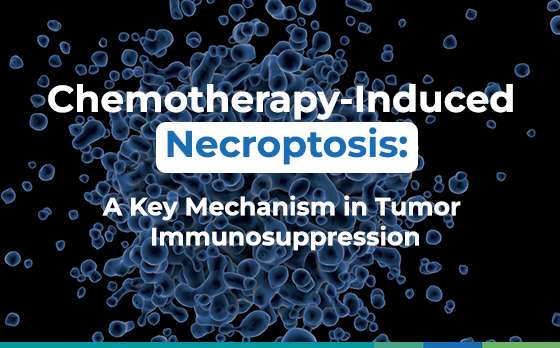Necroptosis and Its Impact on Cancer Immunity
Necroptosis is a regulated form of cell death that, unlike apoptosis (a more “ordered” form of cell death), causes the rupture of the plasma membrane, releasing intracellular contents into the surrounding environment. This process is primarily regulated by the proteins RIPK3 and MLKL, which form a complex known as the necrosome. Once activated, the necrosome perforates the cell membrane, leading to the release of molecules called DAMPs (damage-associated molecular patterns).
Initially, necroptosis was thought to be beneficial for combating tumors by activating the immune system. This belief stems from the ability of DAMPs, such as IL-1α, to function as alarm signals that stimulate immune cells to attack the tumor. Consequently, even though chemotherapy is designed to eliminate tumor cells mainly through apoptosis, in certain contexts, chemotherapeutic drugs can also induce necroptosis.
However, a recent study published in Cancer Cell by Hänggi et al. investigates how necroptosis influences the tumor microenvironment and antitumor immunity. The researchers combined laboratory experiments with animal models to understand how necroptosis and IL-1α affect cancer immunity. They genetically modified breast and lung cancer cell lines to induce necroptosis (controlled cell death). These cells were then implanted into mice to observe the impact on tumor growth and immune responses.
To analyze immune system responses, the researchers used advanced techniques like flow cytometry, which measures the types and activation states of immune cells infiltrating tumors. They also performed single-cell RNA sequencing, which allowed them to identify how immune cells responded to the release of IL-1α. Finally, they conducted IL-1α neutralization assays with antibodies in mice to evaluate whether blocking this protein could improve the outcomes of chemotherapy or immunotherapy.
Necroptosis and IL-1α: An Unexpected Link
The study revealed that tumor cells undergoing necroptosis release IL-1α, which reprograms myeloid cells (macrophages and neutrophils) into immunosuppressive states. This reprogramming reduces the activity of CD8+ T cells, which are crucial for attacking tumors.
The release of IL-1α during necroptosis triggers a cascade of events that transforms the tumor microenvironment into an immune-hostile space. IL-1α induces the production of chemokines like CXCL1 and CXCL2, which attract neutrophils. Instead of attacking the tumor, these neutrophils release immunosuppressive molecules, such as TNF-α, which inhibit the activity of CD8+ T cells—key players in eliminating cancer cells.
In addition, IL-1α reprograms tumor-associated macrophages. Instead of adopting a pro-inflammatory role that stimulates T cells, these macrophages assume a suppressive profile, producing molecules like SPP1 (osteopontin) and CCL2. These factors not only suppress T cells but also recruit additional myeloid cells, perpetuating a cycle of immunosuppression.
Together, these interactions among tumor cells, macrophages, and neutrophils create an environment that supports tumor growth while limiting the effectiveness of antitumor therapies.

Figure 1. Mechanism of immunosuppression induced by free IL-1α due to necroptosis.
Impact on Chemotherapy and Immunity
The research team found that IL-1α is also released during certain types of cell death induced by chemotherapy. In experimental models, neutralizing IL-1α improved the efficacy of treatments such as paclitaxel, a standard chemotherapy, and PD-1 blockade, a type of immunotherapy. These findings suggest that combining strategies to inhibit IL-1α with existing therapies could enhance immune responses against cancer.
Therapeutic Implications
The study proposes that IL-1α is a promising therapeutic target. Its neutralization could be integrated into cancer treatment strategies to improve the effectiveness of current therapies and reduce tumor resistance.
Main Reference: Hänggi, K., Li, J., Gangadharan, A., Liu, X., Celias, D. P., Osunmakinde, O., Keske, A., Davis, J., Ahmad, F., Giron, A., Anadon, C. M., Gardner, A., DeNardo, D. G., Shaw, T. I., Beg, A. A., Yu, X., & Ruffell, B. (2024). Interleukin-1α release during necrotic-like cell death generates myeloid-driven immunosuppression that restricts anti-tumor immunity. Cancer Cell. https://doi.org/10.1016/j.ccell.2024.10.014
Other References:
Chen, D.S., and Mellman, I. (2013). Oncology meets immunology: the cancer-immunity cycle. Immunity 39, 1–10. https://doi.org/10.1016/j.immuni.2013.07.012.
Hanggi, K., and Ruffell, B. (2023). Cell death, therapeutics, and the immune response in cancer. Trends Cancer 9, 381–396. https://doi.org/10.1016/j.trecan.2023.02.001.
Fuchs, Y., and Steller, H. (2015). Live to die another way: modes of programmed cell death and the signals emanating from dying cells. Nat.Rev. Mol. Cell Biol. 16, 329–344. https://doi.org/10.1038/nrm3999
Meier, P., Legrand, A.J., Adam, D., and Silke, J. (2024). Immunogenic cell death in cancer: targeting necroptosis to induce antitumour immunity. Nat. Rev. Cancer 24, 299–315. https://doi.org/10.1038/s41568-024-00674-x


